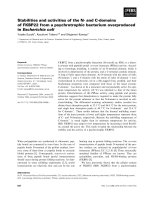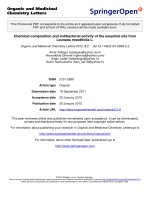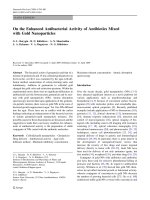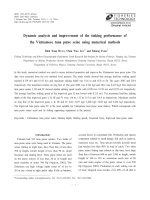Phytochemical analysis and antibacterial activity of annona muricata (laxman phal) against ESBLs producers (Escherichia coli and Klebsiella pneumoniae)
Bạn đang xem bản rút gọn của tài liệu. Xem và tải ngay bản đầy đủ của tài liệu tại đây (322.01 KB, 6 trang )
Int.J.Curr.Microbiol.App.Sci (2017) 6(3): 1339-1344
International Journal of Current Microbiology and Applied Sciences
ISSN: 2319-7706 Volume 6 Number 3 (2017) pp. 1339-1344
Journal homepage:
Original Research Article
/>
Phytochemical Analysis and Antibacterial Activity of
Annona muricata (Laxman phal) against ESBLs Producers
(Escherichia coli and Klebsiella pneumoniae)
N. Kamath1*, Rita Swaminathan2 and Neetin Desai3
1
Department of Microbiology, World College of Medical Sciences and Research and Hospital,
Jhajjar, Harayana, India
2
Department of Microbiology, D.Y. Patil School of Medicine and Hospital,
Nerul, Navi Mumbai, India
3
Department of Biotechnology, Amity University, Panvel, Navi Mumbai, India
*Corresponding author
ABSTRACT
Keywords
Laxman phal,
Kirby-Bauer
technique, Ethanol
extract and aqueous
extract, ESBLextendended
spectrum
betalcatmases.
Article Info
Accepted:
20 February 2017
Available Online:
10 March 2017
The use of plant products as medicine has emerged from traditional days to modern times
of medicine in order to improve the quality life of the patients worldwide. Nature-derived
medicines are considered safer with less or no side effects. The antibacterial effect of the
leaves of Annona muricata was evaluated on bacterial strains of ESBLs: Escherichia coli
and Klebsiella pneumoniae are tested which were isolated from D.Y. Patil Hospital, Nerul,
NaviMumbai. Standard strain of Escherichia coli ATCC 25922 has been tested for
cephalosporin (Ceftazidime- zone of inhibition: 31mm) and Imipenem (zone of inhibition:
25 mm) and is found to be sensitive. The solvents used for the extraction of plants were
water (aqueous) and ethanol. The antibacterial activity was done by using Kirby-Bauer
disc diffusion method. Both extracts showed antibacterial properties but the ethanolic
extract was more effective as it inhibited a wide range of organisms at varying
concentrations. The most susceptible Gram-negative bacteria was Escherichia coli. The
significant antibacterial activity of plant extracts was compared with the standard
antibiotic, Imipenem. The results obtained in the present study suggest that Annona
muricata can be used in treating diseases caused by the test organisms and or can be used
along with the antibiotics having synergistic activity.
Introduction
For centuries, quinine, an alkaloid obtained
from the bark of various species of cinchona
tree has been used in the treatment of malaria;
even aspirin and morphine are plant derived
drugs from willow bark and opium poppy
(Sanjoy et al., 2003). For two thousand years
the powdered roots Rauvolfia serpentina has
been used in treatment of mental illness in
India (Ajay Kumar et al., 2009).
Multidrug resistance has been a biggest threat
to the medical world as bacteria are acquiring
antibiotic resistance day by day. Interesting
conundrums have been encountered in
investigations of links between antibiotic use
and the development of antibiotic resistance
(Julian Davies et al., 2010). Nowadays more
and more bacteria are becoming resistant
which were earlier sensitive to the antibiotics.
1339
Int.J.Curr.Microbiol.App.Sci (2017) 6(3): 1339-1344
Newer antibiotics are not invented or
slowdown in the process of inventing a newer
molecules of antibiotics. The medicinal plants
look promising as it has proved in the past
like a saviour to the medical world.
Annona seed and mixing it with soap and
water is used as effective spray against
caterpillar. The annona leaves are placed
inside the pillow or placed on top of the
mattress to induce a good night sleep.
Annona muricata is a member of the family
of custard apple tree called Annonaceae and a
species of the genus Annona known mostly
for its edible fruits annona. Annona muricata
produces fruits that are usually called 'sour
sop' due to its slightly acidic taste when ripe.
The fruit is juicy, acidic, whitish and aromatic
with abundant seeds, the average weight of
1000 fresh seeds is 470g and has an average
oil content of 24%. The creamy and
delectable flesh of the fruit consist of 80%
water, 1% protein, 18% carbohydrates and
fair amount of vitamins B1, B2 and C,
potassium and dietary fibre. Its flavour is
described as a combination of strawberry and
pineapple with sour citrus flavour contrasting
with an underlying creamy flavour
reminiscent of coconut or banana.
In laboratory studies, annona selectively hunts
down and kills 12 different types of cancer
cells, including breast, prostate, lung, colon
and pancreatic cancer. In view of the
usefulness of this plant, there is a need for
further research on its antimicrobial properties
as well as the determination of its bio-active
components.
Annona muricata has been used as a folkloric
herbal medicine in many regions throughout
the world. It is considered to be
antispasmodic and antiemetic. A decoction of
Annona muricata leaves is used to kill bed
bugs and head lice to reduce fever (Rickettsial
infections or antiparasitic). This can be taken
orally or adding to bathing water also has the
same effect. The crushed fresh leaves are also
applied on skin eruptions for faster healing. A
poultice of young Annona leaf is applied on
the skin to alleviate rheumatism and other
skin infections like eczema. When applied
during the healing of wounds, it results in less
or no skin scars.
The objective of this study was to evaluate the
phytochemical activity and antibacterial
activity of leaves of Annona muricata against
extended beta lactamase producers (ESBL)
Escherichia coli and Klebsiella pneumoniae
as they are multidrug resistant. Multidrug
resistance is exhibited by many bacteria and is
become a big worry in the world of Medicine.
The decoction can also be used as a wet
compress on swollen feet and other
inflammations. The juice of the fruits is taken
orally as an herbal remedy against arthritis,
haematuria and liver ailments. Pulverizing the
The leaves are also traditionally used to
prevent and treat arthritis, asthma, bronchitis,
biliary disorder, diabetes, heart diseases,
hypertension, worm disease, liver disorder,
malaria, rheumatism, tumour, and cancer. The
leaves are also used for the treatment of
several types of diseases caused by bacteria
such as pneumonia, diarrhoea, urinary tract
infection and other kinds of skin diseases.
Materials and Methods
Plant material and solvent extraction
Annona muricata leaves were hand-picked
from home garden in Kundapur, Udupi
District, Karnataka and authenticated. The
leaves were washed with distilled water, air
dried and then shade dried. The dried leaves
were powdered mechanically, subjected to
extraction using Soxhelet apparatus with
ethanol and distilled water as solvents for up
1340
Int.J.Curr.Microbiol.App.Sci (2017) 6(3): 1339-1344
to 48 hours. 10g of leaves powder was
homogenized with 100ml of solvent with a
magnetic stirrer for 30 minutes. Extract was
stored at 40 C in airtight bottles for further
studies. Escherichia coli is common pathogen
which causes Urinary tract infections(UTI),
Diarrhoea and Klebsiella pneumoniae causes
UTI, respiratory infections and hospital
acquired inspections etc.
Bacterial strains
Multidrug resistant tests strains- i.e., ESBLs
were isolated in Microbiology laboratory of
D. Y. Patil Hospital, Nerul, Navi Mumbai.
Standard strains of Escherichia coli ATCC
25922 was taken from the stock culture. The
presence of an ESBL-producing organism in
an infection can result in treatment failure if
one of the drugs is used (2nd Generation
cephalosporins). ESBLs can be difficult to
detect because they have different levels of
activity against various cephalosporins. Thus,
the choice of which antimicrobial agents to
test is critical. For example, one enzyme may
actively hydrolyze ceftazidime, resulting in
ceftazidime
minimum
inhibitory
concentrations (MICs) of 256 µg/ml, but have
poor activity on cefotaxime, producing MICs
of only 4 µg/ml. If an ESBL is detected, all
penicillins, cephalosporins, and aztreonam
should be reported as resistant, even if in vitro
test results indicate susceptibility as per CLSI
(Clinical and Laboratory Standards Institute)
guidelines.
extracts and standard antibiotics in triplicate.
The plates were allowed to settle for one hour
in the room temperature first, then incubated
at 370C for 16-24 hours. Zone of inhibition is
measured in millimetres (mm) as compared
against standard antibiotics.
Results and Discussion
Preliminary phytochemical analysis revealed
the presence of secondary metabolites like
tannins, steroids, cardiac glycosides, etc. were
present in the leaves. Table 1 shows the
results of the phytochemicals present in
Annona muricata leaves. However, the
present study of in- vitro antimicrobial
evaluation of the leaves of Annona muricata
forms a primary platform for further
phytochemical and pharmacological studies.
The antibacterial activity of the leaves of
Annona muricata extracts was tested in-vitro
by Kirby-Bauer Disk diffusion technique
against two bacterial species (ESBLs) and one
standard strain of antibiotic sensitive bacteria.
Table 2 summarizes the microbial growth
inhibition of both ethanol and aqueous
extracts.
Ethanol extract of Anona muricata(leaves)
exhibited antibacterial activity towards all the
tested bacteria with high antibacterial activity.
The ethanol extracts of the investigated plants
showed maximum antibacterial activity than
aqueous extract for both E. coli and
K.pneumoniae.
Antibacterial testing on ESBLs
The Whatman no.1 filter paper discs were
prepared from 50µl and 100 µl of plant
extracts and antibiotic sensitivity testing was
done by Kirby-Bauer disc diffusion technique
by inoculating the bacterial strains (turbidity
of the broth was adjusted to 0.5 McFarland
standard) on Mueller–Hinton agar by lawn
culture and placing the discs with plant
It was found that the ethanolic extract of the
leaves was effective against Escherichia coli
and Klebsiella pneumoniae (both are ESBL
producers). The Comparative antibacterial
activity between ethanolic extract of Annona
muricata and standard antibiotic Imipenem
was studied. The ethanolic extract showed
significant antibacterial efficacy as compared
to the standard antibiotic.
1341
Int.J.Curr.Microbiol.App.Sci (2017) 6(3): 1339-1344
Zone of inhibition with standard strain E. coli
ATCC 25922 showed 25mm with aqueous
extract of A. muricata and with ethanol
extract of A. muricata showed 27mm which is
at par with standard antibiotic disc Imipenem.
Table.1 Phytochemical analysis of the leaves of Annona muricata
Tests
Reducing sugars,
Fehling’s test
Starch, Iodine test
Test for Steriods
Keller-Killani test
Dragendorff’s test
Saponins Absent
Borntrager’s test
Ferric chloride test
Test for Phenolics
Test for Flavonoids
Aqueous
extract
+
Methanol
Extract
+
+
+
+
-
+
+
+
-
Inference
Carbohydrates Present
Polysaccharides Absent
Steroids Present
Cardiac Glycosides Present
Alkaloids Absent
Test for Saponin
Anthraquinone Glycoside Absent
Tannins Present
Phenols Absent
Flavonoids Absent
Table.2 Antibiotic susceptibility of the ethanolic (leaves) and
aqueous extract (leaves) of Annona muricata
Test Organisms
Concentration of
ethanolic extract
100 (mg/ml)
Zone of inhibition
measured in mm
Escherichia coli
Klebsiella
pneumoniae
Test Organisms
16.5 ± 0.5
14.0 ±0.5
Escherichia coli
Klebsiella
pneumoniae
14.5 ±0.5
13.5.5 ± 0.5
Concentration of
aqueous extract
100 (mg/ml)
Zone of
inhibition
measured in mm
Concentration of
ethanolic extract
50
(mg/ml)
Zone of inhibition
measured in mm
14.0 ±0.5
13±0.5
Positive control
Imipenem
Concentration of
aqueous extract
50
(mg/ml)
Zone of
inhibition
measured in mm
13 ±0.5
13.0 ±.5
Positive control for Negative control
Imipenem
(distilled water)
50 µl
Zone of
Zone of inhibition inhibition
measured in mm
measured in mm
1342
Zone of inhibition
measured in mm
21.0±0.5
23.0 ±0.5
21.0 ± 0.5
23.0 ±00.5
Negative control
(Ethanol)
50 µl
Zone of
inhibition
measured in mm
0.00
0.00
0.00
0.00
Int.J.Curr.Microbiol.App.Sci (2017) 6(3): 1339-1344
Picture.1 and 2 Photographs of Annona muricata (leaves and fruit)
Phytochemical analysis revealed the presence
of secondary metabolites like carbohydrates,
polysaccharides, steroids, cardiac glycosides
and tannins which is also reported by (Julian
Davies et al., 2010).
Both aqueous and ethanolic leaves extract of
Annona muricata showed antibacterial
activity. Ethanolic extract showed higher
antibiotic activity which is in line with the
previous workers.
Significant (P<0.05) antibacterial efficacy
which can compete with standard antibiotics
i.e., Imipenem in ESBLs (Escherichia coli
and Klebsiella pneumoniae), the beneficial
effects of treatment can be achieved with the
treatment with the leaves of Annona muricata
in various bacterial infectious diseases like
pneumonia, diarrhoea, urinary tract infection,
and even some skin disease. It will require a
multi-pronged approach that includes the
development of new drugs. Using plants as
the inspiration for new drugs provides an
infusion of novel compounds or substances
for healing disease (Iwu et al., 1999). Annona
muricata (soursop) is a potent anticancer
plant of Annonaceae family. The therapeutic
potentials of the n-butanolic extract of
Annona muricata were studied on WRL-68,
MDA-MB-435S and HaCaT cell lines. Since
most of the chemotherapeutic drugs affect
normal cells as well, WRL- 68 cells were
analysed for the relative cytotoxic response in
with comparison that quantified in MDA-MB435S and HaCaT cell lines. n-Butanolic leaf
extract of A. muricata possess significant
anticancer potentials in humancancerous cells.
Plant phenolics are a major group of
compounds that act as primary antioxidants or
free radical scavengers. Broad spectrum of
antibacterial activity and phytochemical
activity is exhibited by Annona muricata.
According to Parbha Pathak et al., (2010)
1343
Int.J.Curr.Microbiol.App.Sci (2017) 6(3): 1339-1344
most susceptible bacteria was K. pneumoniae
with Annona muricata leaves extract.
Isolation of two new Annonaceous
acetogenins, annocatacin A and annocatacin
B from the seeds and the leaves which is
proved to be which showed in-vitro
cytotoxicity towards human hepatoma cell
lines (Chang et al., 2003). The plant possess
the major pharmacological activities includes
cytotoxic, antileishmanial, wound healing,
anti-microbial activity (Geetalaxmi et al.,
2012). ESBLs show antibiotic resistance
(<10mm) in disc diffusion technique and the
results with leaves extracts show better
activity than cephalosporins.
In conclusion, Annona muricata extract
possesses a broad spectrum of activity against
ESBL producers (Escherichia coli and
Klebsiella pneumoniae) which responsible for
the most common bacterial diseases.
Ethanolic extracts showed better antibacterial
activity when compared with aqueous
extracts. Phytochemicals present in the leaves
support the antibacterial activity. These
promissory extracts open the possibility of
finding new clinically effective antibacterial
compounds. Leaves extracts have good
antibacterial activity which can supplement
moderately sensitive antibiotics. So combined
activity can prove to be beneficial in treating
the patients suffering from ESBL producing
bacteria. Leaves extract of Annona muricata
has lot to promise in further years to come by
biomedical research.
References
Ajay Kumar Meena, Parveen Bansal, Sanjiv
Kumar. 2009. Plants-herbal wealth as a
potential source of ayurvedic drugs, Asian
J. Traditional Med., 4(4).
Biba, V.S., Amily, A., Sangeetha, S., and
Remani, P. 2014. Anticancer, antioxidant
and antimicrobial activity of Annonaceae
family, Vol. 3, Issue 3, 1595-1604.
Chang, F.R., Liaw, C.C., Lin, C.Y., Chou, C.J.,
Chiu, H.F., Wu, Y.C. 2003. New adjacent
Bis-tetrahydrofuran
Annonaceous
acetogenins from Annona muricata,
Europe Pub med Central Planta Medica,
69(3): 241-246.
Geetalaxmi, S., Vijayalaxmi, S. and Devi
Rajesswari, V. 2012. Phytochemical and
pharmacological properties of Annona
muricata: A Review, Int. J. Pharm.
Pharma. Sci., Vol 4, Issue 2.
Iwu, M.M., Duncan, A.R., and Okunji, C.O.
1999. New Antimicrobials of Plant
Origin, J. Natural Products, 457–462.
Julian Davies and Davies. 2010. Origins and
Evolution of Antibiotic Resistance,
Microbiol. Mol. Biol. Rev., 74(3): 417–
433.
Pathak, Saraswathy, D., and Vora, S. 2010. In
vitro
antimicrobial
activity
and
phytochemical analysis of the leaves of
Annona muricata, Int. J. Pharma. Res.
Develop., (5): 1–6.
Sanjoy Kumar Pal, Yogeshwer Shukla. 2003.
Asian Herbal Medicine: Current Status
and the Future, Pacific J. Cancer Prev.,
Vol. 4: 281-288
How to cite this article:
Kamath, N., Rita Swaminathan and Neetin Desai. 2017. Phytochemical analysis and
antibacterial activity of Annona muricata (Laxman phal) against ESBLs producers (Escherichia
coli and Klebsiella pneumoniae). Int.J.Curr.Microbiol.App.Sci. 6(3): 1339-1344.
doi: />
1344









